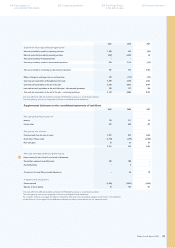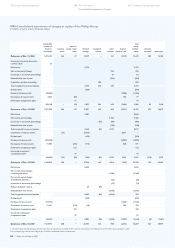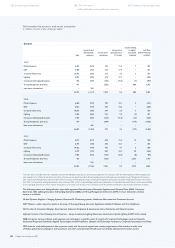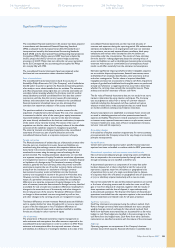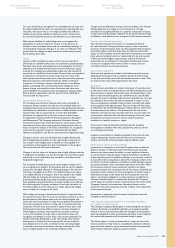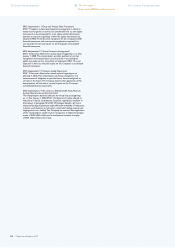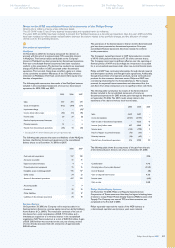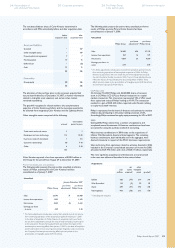Philips 2007 Annual Report Download - page 202
Download and view the complete annual report
Please find page 202 of the 2007 Philips annual report below. You can navigate through the pages in the report by either clicking on the pages listed below, or by using the keyword search tool below to find specific information within the annual report.
Philips Annual Report 2007208
Other non-current nancial assets
Other non-current nancial assets include available-for-sale securities,
held-to-maturity securities, loans and cost-method investments.
The Company classies its investments in equity securities that have
readily determinable fair values as either available-for-sale or for
trading purposes. Trading securities are acquired and held principally
for the purpose of selling them in the short term and are presented as
‘Other current assets’. Trading securities are recorded at fair value
with changes in the fair value recorded in nancial income and expense.
Held-to-maturity securities are those debt securities in which the
Company has the ability and intent to hold the security until maturity.
Held to-maturity debt securities are recorded at amortized cost,
adjusted for the amortization or accretion of premiums or discounts
using the effective interest method.
All securities not included in trading or held-to-maturity are classied
as available-for-sale. Available-for-sale securities are recorded at fair
value. Unrealized holding gains and losses, net of the related tax effect,
on available-for-sale equity securities are reported as a separate
component of equity until realized. Realized gains and losses from
the sale of available-for-sale securities are determined on a rst-in,
rst-out basis. For available-for-sale securities hedged under a fair
value hedge, the changes in the fair value that are attributable to the
risk which is being hedged are recognized in the income statement
rather than in equity.
Loans receivable are stated at amortized cost, less the related
allowance for impaired loans receivable.
Investments in privately held companies that are not equity-accounted
investees, are carried at cost.
Impairment of nancial assets
A nancial asset is considered to be impaired if objective evidence
indicates that one or more events have had a negative effect on the
estimated future cash ows of that asset. In case of available-for-sale
securities, a signicant or prolonged decline in the fair value of the
security below its cost is considered an indicator that the securities
are impaired. If any such evidence exists for available-for-sale nancial
assets, the cumulative loss - measured as the difference between the
acquisition cost and the current fair value, less any impairment loss on
that nancial asset previously recognized in the income statement -
is removed from equity and recognized in the income statement.
If objective evidence indicates that cost-method investments need
to be tested for impairment, calculations are based on information
derived from business plans and other information available for
estimating their fair value. Any impairment loss is charged to the
income statement.
An impairment loss related to nancial assets is reversed if and to the
extent there has been a change in the estimates used to determine
the recoverable amount. The loss is reversed only to the extent that
the asset’s carrying amount does not exceed the carrying amount
that would have been determined, if no impairment loss had been
recognized. Reversals of impairment are recognized in net income
except for reversals of impairment of available-for-sale equity
securities, which are recognized in equity.
Inventories
Inventories are stated at the lower of cost or net realizable value,
less advance payments on work in progress. The cost of inventories
comprises all costs of purchase, costs of conversion and other costs
incurred in bringing the inventories to their present location and
condition. The costs of conversion of inventories include direct labor
and xed and variable production overheads, taking into account the
stage of completion and the normal capacity of production facilities.
Costs of idle facility and waste are expensed. The cost of inventories
is determined using the rst-in, rst-out (FIFO) method. Inventory is
reduced for the estimated losses due to obsolescence. This reduction
is determined for groups of products based on purchases in the recent
past and/or expected future demand.
Property, plant and equipment
Property, plant and equipment is stated at cost, less accumulated
depreciation. Assets manufactured by the Company include direct
manufacturing costs, production overheads and interest charges
incurred for qualifying assets during the construction period.
Government grants are deducted from the cost of the related asset.
Depreciation is calculated using the straight-line method over the
useful life of the asset. Depreciation of special tooling is generally also
based on the straight-line method. Gains and losses on the sale of
property, plant and equipment are included in other business income.
Costs related to repair and maintenance activities are expensed in
the period in which they are incurred unless leading to an extension
of the original lifetime or capacity.
Plant and equipment under nance leases and leasehold improvements
are amortized using the straight-line method over the shorter of the
lease term or the estimated useful life of the asset. The gain realized
on sale and operating leaseback transactions that are concluded at
market conditions is recognized at the time of the sale.
The Company capitalizes interest as part of the cost of assets that
take a substantial period of time to get ready for use.
Intangible assets other than goodwill
Acquired denite-lived intangible assets are amortized using the
straight-line method over their estimated useful life. The useful lives
are evaluated every year. Brands acquired from third parties that
are expected to generate cash inows during a period without a
foreseeable limit, are regarded as intangible assets with an indenite
useful life. These brands are not amortized, but tested for impairment
annually or whenever an impairment trigger indicates that the asset
may be impaired. Patents and trademarks acquired from third parties
are capitalized at cost and amortized over their remaining useful lives.
The Company expenses all research costs as incurred. Expenditure on
development activities, whereby research ndings are applied to a plan
or design for the production of new or substantially improved products
and processes, is capitalized as an intangible asset if the product or
process is technically and commercially feasible and the Company
has sufcient resources to complete development.
The development expenditure capitalized includes the cost of materials,
direct labor and an appropriate proportion of overheads. Other
development expenditure and expenditure on research activities is
recognized in the income statement as an expense as incurred.
Capitalized development expenditure is stated at cost less accumulated
amortization and impairment losses. Amortization of capitalized
development expenditure is charged to the income statement on a
straight-line basis over the estimated useful lives of the intangible assets.
The useful lives for the intangible development assets are 3 – 5 years.
Costs relating to the development and purchase of software for both
internal use and software intended to be sold are capitalized and
subsequently amortized over the estimated useful life of 3 years.
Impairment of non-nancial assets other than goodwill, inventories
and deferred tax assets
Non-nancial assets other than goodwill, inventories and deferred tax
assets are reviewed for impairment whenever events or changes in
circumstances indicate that the carrying amount of an asset may
not be recoverable. Recoverability of assets to be held and used is
recognized and measured by a comparison of the carrying amount of
an asset with the greater of its value in use and its fair value less cost
to sell. Value in use is measured as the present value of future cash
ows expected to be generated by the asset. If the carrying amount
of an asset is not recoverable, an impairment charge is recognized in
the amount by which the carrying amount of the asset exceeds the
recoverable amount. The review for impairment is carried out at the
level where discrete cash ows occur that are independent of other
cash ows.
An impairment loss related to intangible assets other than goodwill,
tangible xed assets, inventories and equity-accounted investees is
reversed if and to the extent there has been a change in the estimates
used to determine the recoverable amount. The loss is reversed only
to the extent that the asset’s carrying amount does not exceed the
carrying amount that would have been determined, net of depreciation
or amortization, if no impairment loss had been recognized. Reversals
of impairment are recognized in net income.
Goodwill
Goodwill represents the excess of the cost of an acquisition over the
fair value of the Company’s share of the net identiable assets of the
acquired subsidiary/equity-accounted investee at the date of acquisition.
Goodwill is measured at cost less accumulated impairment losses. In
respect of equity-accounted investees, the carrying amount of goodwill
is included in the carrying amount of the investment.
128 Group nancial statements 188 IFRS information
Signicant IFRS accounting policies
240 Company nancial statements



